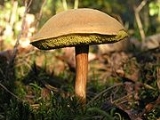
Xerocomus
Encyclopedia
Xerocomus is a genus
of fungi which is closely related to Boletus
. Many mycologists do not recognize the distinction.
Most members of Xerocomus are edible
.
Ladurner and Simonini published a monograph on Xerocomus in 2003.
Molecular phylogenetic studies strongly imply that Xerocomus is a heterogeneous genus of polyphyletic origin.
Genus
In biology, a genus is a low-level taxonomic rank used in the biological classification of living and fossil organisms, which is an example of definition by genus and differentia...
of fungi which is closely related to Boletus
Boletus
Boletus is a genus of mushroom, comprising over 100 species. The genus Boletus was originally broadly defined and described by Elias Magnus Fries in 1821, essentially containing all fungi with pores...
. Many mycologists do not recognize the distinction.
Most members of Xerocomus are edible
Edible mushroom
Edible mushrooms are the fleshy and edible fruiting bodies of several species of fungi. Mushrooms belong to the macrofungi, because their fruiting structures are large enough to be seen with the naked eye. They can appear either below ground or above ground where they may be picked by hand...
.
Ladurner and Simonini published a monograph on Xerocomus in 2003.
Molecular phylogenetic studies strongly imply that Xerocomus is a heterogeneous genus of polyphyletic origin.
Species
- X. badiusBoletus badiusBoletus badius , and commonly known as the Bay Bolete is an edible, pored mushroom from Europe and North America...
(edible and often known as Boletus badius) - X. chrysenteronXerocomus chrysenteronBoletus chrysenteron is a small, edible, wild mushroom in the Boletaceae family. These mushrooms have tubes and pores instead of gills beneath their caps...
(edible and very common) - X. silwoodensisXerocomus silwoodensisXerocomus silwoodensis is a species of fungus first described in 2007. It was first discovered by scientists on Silwood Campus, Imperial College, London as was named after this accordingly. Its discovery on a campus of a leading academic institution has been used to show how little is known about...
(edibility not known, found in EnglandEnglandEngland is a country that is part of the United Kingdom. It shares land borders with Scotland to the north and Wales to the west; the Irish Sea is to the north west, the Celtic Sea to the south west, with the North Sea to the east and the English Channel to the south separating it from continental...
, SpainSpainSpain , officially the Kingdom of Spain languages]] under the European Charter for Regional or Minority Languages. In each of these, Spain's official name is as follows:;;;;;;), is a country and member state of the European Union located in southwestern Europe on the Iberian Peninsula...
, and ItalyItalyItaly , officially the Italian Republic languages]] under the European Charter for Regional or Minority Languages. In each of these, Italy's official name is as follows:;;;;;;;;), is a unitary parliamentary republic in South-Central Europe. To the north it borders France, Switzerland, Austria and...
. Named seventh top species of 2008, International Institute for Species ExplorationInternational Institute for Species ExplorationThe International Institute for Species Exploration is a research institute hosted by Arizona State University, dedicated to improving taxonomical exploration and the cataloguing of new species of flora and fauna. It is located in Tempe, Arizona, in the United States of America. The institute's...
) - X. subtomentosus (edible and very common)
- X. truncatus (edible and very common)

